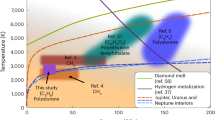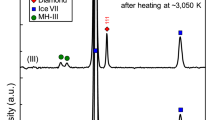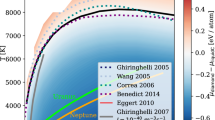Abstract
The effects of hydrocarbon reactions and diamond precipitation on the internal structure and evolution of icy giant planets such as Neptune and Uranus have been discussed for more than three decades1. Inside these celestial bodies, simple hydrocarbons such as methane, which are highly abundant in the atmospheres2, are believed to undergo structural transitions3,4 that release hydrogen from deeper layers and may lead to compact stratified cores5,6,7. Indeed, from the surface towards the core, the isentropes of Uranus and Neptune intersect a temperature–pressure regime in which methane first transforms into a mixture of hydrocarbon polymers8, whereas, in deeper layers, a phase separation into diamond and hydrogen may be possible. Here we show experimental evidence for this phase separation process obtained by in situ X-ray diffraction from polystyrene (C8H8) n samples dynamically compressed to conditions around 150 GPa and 5,000 K; these conditions resemble the environment around 10,000 km below the surfaces of Neptune and Uranus9. Our findings demonstrate the necessity of high pressures for initiating carbon–hydrogen separation3 and imply that diamond precipitation may require pressures about ten times as high as previously indicated by static compression experiments4,8,10. Our results will inform mass–radius relationships of carbon-bearing exoplanets11, provide constraints for their internal layer structure and improve evolutionary models of Uranus and Neptune, in which carbon–hydrogen separation could influence the convective heat transport7.
This is a preview of subscription content, access via your institution
Access options
Access Nature and 54 other Nature Portfolio journals
Get Nature+, our best-value online-access subscription
$29.99 / 30 days
cancel any time
Subscribe to this journal
Receive 12 digital issues and online access to articles
$119.00 per year
only $9.92 per issue
Buy this article
- Purchase on Springer Link
- Instant access to full article PDF
Prices may be subject to local taxes which are calculated during checkout




Similar content being viewed by others
References
Ross, M. The ice layer in Uranus and Neptune—diamonds in the sky? Nature 292, 435–436 (1981).
Guillot, T. Interiors of giant planets inside and outside the Solar System. Science 286, 72–77 (1999).
Ancilotto, F., Chiarotti, G. L., Scandolo, S. & Tosatti, E. Dissociation of methane into hydrocarbons at extreme (planetary) pressure and temperature. Science 275, 1288–1290 (1997).
Benedetti, L. R. et al. Dissociation of CH4 at high pressures and temperatures: diamond formation in giant planet interiors? Science 286, 100–103 (1999).
Hubbard, W. B., Nellis, W. J., Mitchell, A. C., Limaye, S. S. & McCandless, P. C. Interior structure of Neptune: comparison with Uranus. Science 253, 648–651 (1991).
Chau, R., Hamel, S. & Nellis, W. J. Chemical processes in the deep interior of Uranus. Nat. Commun. 2, 203 (2011).
Nettelmann, N. et al. Uranus evolution models with simple thermal boundary layers. Icarus 275, 107–116 (2016).
Lobanov, S. S. et al. Carbon precipitation from heavy hydrocarbon fluid in deep planetary interiors. Nat. Commun. 4, 2446 (2013).
Helled, R., Anderson, J. D., Podolak, M. & Schubert, G. Interior models of Uranus and Neptune. Astrophys. J. 7, 15 (2011).
Hirai, H., Konagai, K., Kawamurab, T., Yamamotob, Y. & Yagic, T. Polymerization and diamond formation from melting methane and their implications in ice layer of giant planets. Phys. Earth Planet. Inter. 174, 242–246 (2009).
Helled, R., Podolak, M. & Vos, E. Methane planets and their mass–radius relation. Astrophys. J. Lett. 805, L11 (2015).
Nellis, W. J., Ree, F. H., van Thiel, M. & Mitchell, A. C. Shock compression of liquid carbon monoxide and methane to 90 GPa (900 kbar). J. Chem. Phys. 75, 3055–3063 (1981).
Nellis, W. J., Hamilton, D. C. & Mitchell, A. C. Electrical conductivities of methane, benzene, and polybutene shock compressed to 60 GPa (600 kbar). J. Chem. Phys. 115, 1015–1019 (2001).
Gao, G. et al. Dissociation of methane under high pressure. J. Chem. Phys. 133, 144508 (2010).
Sherman, B. L., Wilson, H. F., Weeraratne, D. & Militzer, B. Ab initio simulations of hot dense methane during shock experiments. Phys. Rev. B 86, 224113 (2012).
Uzan-Saguy, C. et al. Diffusion of hydrogen from a microwave plasma into diamond and its interaction with dopants and defects. Diamond Related Mater. 11, 316–322 (2002).
Ahmed, S., Abdullah, A., Rahman, F., Al-Dawood, A. & Al-Muhaish, F. Decomposition of hydrocarbons to hydrogen and carbon. Appl. Catal. A 359, 1–24 (2009).
Wang, X., Scandolo, S. & Car, R. Carbon phase diagram from ab initio molecular dynamics. Phys. Rev. Lett. 95, 185701 (2005).
Kraus, D. et al. Nanosecond formation of diamond and lonsdaleite by shock compression of graphite. Nat. Commun. 7, 10970 (2016).
Glenzer, S. H. et al. Matter under extreme conditions experiments at the Linac Coherent Light Source. J. Phys. B 49, 092001 (2016).
Barker, L. M. & Hollenbach, R. E. Laser interferometer for measuring high velocities of any reflecting surface. J. Appl. Phys. 43, 4669–4675 (1972).
MacFarlane, J. J., Golovkin, I. E. & Woodruff, P. R. HELIOS-CR: A 1-D radiation–magnetohydrodynamics code with inline atomic kinetics modeling. J. Quant. Spectrosc. Radiat. Transfer 99, 381–397 (2006).
Lyon, S. P. & Johnson, J. D. SESAME: The Los Alamos National Laboratory Equation of State Database. LANL Report No. LA-UR-92-3407 (1992).
Barrios, M. A. et al. High-precision measurements of the equation of state of hydrocarbons at 1–10 Mbar using laser-driven shock waves. Phys. Plasmas 17, 056307 (2010).
Guillot, T. & Gautier, D. Giant planets. Treatise Geophys. 10, 439–464 (2007).
Scherrer, P. Bestimmung der Größe und der inneren Struktur von Kolloidteilchen mittels Röntgenstrahlen. Gött. Nachr. 2, 98 (1918).
Kraus, D. et al. Probing the complex ion structure in liquid carbon at 100 GPa. Phys. Rev. Lett. 111, 255501 (2013).
Benedict, L. X. et al. Multiphase equation of state for carbon addressing high pressures and temperatures. Phys. Rev. B 89, 224109 (2014).
Püstow, R., Nettelmann, N., Lorenzen, W. & Redmer, R. H/He demixing and the cooling behavior of Saturn. Icarus 267, 323–333 (2016).
Mochalin, V. N., Shenderova, O., Ho, D. & Gogotsi, Y. The properties and applications of nanodiamonds. Nat. Nanotech. 7, 11–23 (2012).
Celliers, P. M. et al. Line-imaging velocimeter for shock diagnostics at the OMEGA laser facility. Rev. Sci. Instrum 75, 4916–4929 (2004).
Rigg, P. A., Knudson, M. D., Scharff, R. J. & Hixson, R. S. Determining the refractive index of shocked [100] lithium fluoride to the limit of transmissibility. J. Appl. Phys. 116, 033515 (2014).
Forbes, J. W. Shock Wave Compression of Condensed Matter (Springer, Berlin/Heidelberg, 2012).
Herrmann, S. et al. CSPAD-140k: a versatile detector for LCLS experiments. Nucl. Instrum. Methods Phys. Res. A 718, 550–553 (2013).
Acknowledgements
We thank L. Divol, L. R. Benedetti, S. Hamel and L. X. Benedict for discussions. This work was performed at the Matter at Extreme Conditions (MEC) instrument of LCLS, supported by the US Department of Energy (DOE) Office of Science, Fusion Energy Science, under contract no. SF00515. D.K., A.M.S. and R.W.F acknowledge support by the DOE Office of Science, Fusion Energy Sciences and by the National Nuclear Security Administration under awards DE-FG52-10NA29649 and DE-NA0001859. D.K., N.J.H. and A.K.S. were supported by the Helmholtz Association under VH-NG-1141. SLAC HED is supported by DOE Office of Science, Fusion Energy Science under FWP 100182. S.F. and M.R. were supported by German Bundesministerium für Bildung und Forschung project no. 05P15RDFA1. E.E.M. was supported by funding from Volkswagen Stiftung. The work of A.P., S.F. and T.D. was performed under the auspices of the US DOE by Lawrence Livermore National Laboratory under contract no. DE-AC52-07NA27344.
Author information
Authors and Affiliations
Contributions
D.K., R.W.F., J.V., T.D., A.P., S.H.G., D.O.G., M.R., E.Ga., E.Gr., P.N. and A.J.M. were involved in the project planning. D.K., E.Ga., N.J.H., A.P., T.D., P.N., E.E.M., A.M.S., S.F., L.B.F., P.S., M.J.M., E.J.G., E.Gr., I.N. and T.v.D. carried out the experiment. Experimental data were analysed and discussed by D.K., J.V., N.J.H., A.K.S., S.H.G., D.O.G., A.P., E.E.M. and T.D. The manuscript was written by D.K., J.V., A.P., N.J.H., M.J.M., D.O.G. and T.D.
Corresponding author
Ethics declarations
Competing interests
The authors declare no competing financial interests.
Additional information
Publisher’s note: Springer Nature remains neutral with regard to jurisdictional claims in published maps and institutional affiliations.
Electronic supplementary material
Supplementary Information
Supplementary Figures 1–4
Rights and permissions
About this article
Cite this article
Kraus, D., Vorberger, J., Pak, A. et al. Formation of diamonds in laser-compressed hydrocarbons at planetary interior conditions. Nat Astron 1, 606–611 (2017). https://doi.org/10.1038/s41550-017-0219-9
Received:
Accepted:
Published:
Issue Date:
DOI: https://doi.org/10.1038/s41550-017-0219-9
This article is cited by
-
Diamond precipitation dynamics from hydrocarbons at icy planet interior conditions
Nature Astronomy (2024)
-
Significance of the high-pressure properties and structural evolution of gas hydrates for inferring the interior of icy bodies
Progress in Earth and Planetary Science (2023)
-
Production of diamond using intense heavy ion beams at the FAIR facility and application to planetary physics
Scientific Reports (2023)
-
Materials under extreme conditions using large X-ray facilities
Nature Reviews Methods Primers (2023)
-
Thermodynamics of diamond formation from hydrocarbon mixtures in planets
Nature Communications (2023)



